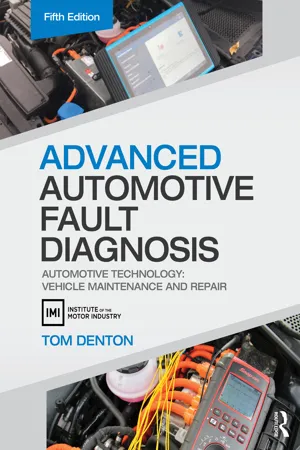
Advanced Automotive Fault Diagnosis
Automotive Technology: Vehicle Maintenance and Repair
- 396 pages
- English
- ePUB (mobile friendly)
- Available on iOS & Android
About this book
Diagnostics: Test don't guess.
Learn all the skills you need to pass Level 3 and 4 Vehicle Diagnostics courses from IMI, City & Guilds, and BTEC, as well as ASE, AUR, and other higher-level qualifications.
Along with 25 new real-life case studies, this fifth edition of Advanced Automotive Fault Diagnosis includes new content on diagnostic tools and equipment: VCDS, decade boxes, scanners, pass through, sensor simulators, break out boxes, multimeter updates for HV use, and more . It explains the fundamentals of vehicle systems and components, and it examines diagnostic principles and the latest techniques employed in effective vehicle maintenance and repair. Diagnostics, or faultfinding, is an essential part of an automotive technician's work, and as automotive systems become increasingly complex there is a greater need for good diagnostic skills.
Ideal for students, included throughout the text are useful definitions, key facts, and 'safety first' notes. This text will also assist experienced technicians to further improve their performance and keep up with recent industry developments.
Frequently asked questions
- Essential is ideal for learners and professionals who enjoy exploring a wide range of subjects. Access the Essential Library with 800,000+ trusted titles and best-sellers across business, personal growth, and the humanities. Includes unlimited reading time and Standard Read Aloud voice.
- Complete: Perfect for advanced learners and researchers needing full, unrestricted access. Unlock 1.4M+ books across hundreds of subjects, including academic and specialized titles. The Complete Plan also includes advanced features like Premium Read Aloud and Research Assistant.
Please note we cannot support devices running on iOS 13 and Android 7 or earlier. Learn more about using the app.
Information
1.1Diagnosis
1.1.1What is needed to find faults?
- understanding of the system in which the problem exists;
- the ability to apply a logical diagnostic routine.
- symptom(s) – what the user/operator/repairer of the system (vehicle or whatever) notices;
- fault(s) – the error(s) in the system that result in the symptom(s);
- root cause(s) – the cause(s) of the fault.

1.2Safe Working Practices
1.2.1Introduction
1.2.2Risk assessment and reduction
Identified risk | Reducing the risk |
Battery acid | Sulphuric acid is corrosive, so always use good PPE – in this case overalls and if necessary rubber gloves. A rubber apron is ideal as are goggles if working with batteries a lot, particularly older types. |
Electric shock | Ignition HT is the most likely place to suffer a shock – up to 25000V is quite normal. Use insulated tools if it is necessary to work on HT circuits with the engine running. Note that high voltages are also present on circuits containing windings due to back emf as they are switched off – a few hundred volts is common. Mains supplied power tools and their leads should be in good condition, and using an earth leakage trip is highly recommended. |
Exhaust gases | Suitable extraction must be used if the engine is running indoors. Remember it is not just the CO that might make you ill or even kill you, other exhaust components could also cause asthma o... |
Table of contents
- Cover
- Half Title
- Title Page
- Copyright Page
- Contents
- Preface
- Acknowledgements
- 1 Introduction
- 2 Diagnostic techniques
- 3 Tools and equipment
- 4 Sensors, actuators and oscilloscope diagnostics
- 5 On-board diagnostics
- 6 Engine systems
- 7 Chassis systems
- 8 Electrical systems
- 9 Transmission systems
- 10 Practical diagnostics
- Glossary of abbreviations and acronyms
- Index